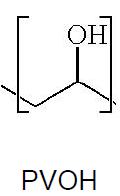


 علم الكيمياء
علم الكيمياء 
 الكيمياء التحليلية
الكيمياء التحليلية 
 الكيمياء الحياتية
الكيمياء الحياتية 
 الكيمياء العضوية
الكيمياء العضوية 
 الكيمياء الفيزيائية
الكيمياء الفيزيائية
 الكيمياء اللاعضوية
الكيمياء اللاعضوية 
 مواضيع اخرى في الكيمياء
مواضيع اخرى في الكيمياء
 الكيمياء الصناعية
الكيمياء الصناعية |
Read More
Date: 12-1-2020
Date: 29-9-2017
Date: 29-9-2017
|
Polyvinyl alcohol (PVOH)
Polyvinyl alcohol is a biodegradable polymer obtained by partial or complete hydrolysis of polyvinyl acetate (PVA, of petrochemical origin) to remove acetate groups. The vinyl alcohol monomer almost exclusively exists as the tautomeric form acetaldehyde, which does not polymerize.

PVOH is the only water soluble biodegradable polymer, whose main chain consists only of carbon atoms. Solubility and biodegradability are imparted by the hydroxyl groups, that are capable of establishing hydrogen bonds with water. The partial hydrolysis leaves acetate residues, that allow PVOH solubility in cold water, and decrease the biodegradability. At a hydrolysis level close to 100%, the polymer is soluble only in hot water and is completely biodegradable. Even being an atactic polymer, with non-organized space distribution of the hydroxyl groups in the main chain, PVOH shows crystallinity, because the hydroxyl groups are small enough to accommodate within the crystal, not hindering it.
PVOH can not be processed by conventional extrusion, because it decomposes (from about 150 oC up) before reaching its melting temperature of 230 °C, with release of water and formation of terminal unsaturation. Partially hydrolyzed products, with melting temperatures of 180-190 °C, containing internal plasticizer (such as water, glycerol, ethylene glycol and its dimer and trimer, etc.) decompose only slightly during extrusion.
Among the leading manufacturers are Hydrolene (Idroplast), Celanese (Celvol), DuPont (Elvanol), Air Products, Kuraray, Hisun, Ranjan and Wacker, as well as some major Chinese producers, working for several years. Annual production exceeds 1 million tons.
Some major applications are: thickener in paint industry; paper coating, hair sprays; shampoos; adhesives; biodegradable products for the feminine hygiene; diapers bottoms; water soluble packaging films (detergents, disinfectants, scouring powder, pesticides, fertilizer, laundry, etc.); fibers for concrete reinforcement; lubricant for eye drops and contact lenses; and material for chemical resistant gloves.
It is believed that the PVOH degrading microorganisms are not spread throughout the environment, and that they are predominantly bacteria and fungi (yeasts and moulds). Before the start of biodegradation, a period of acclimatization may be required.
Acclimatization (natural conditions) and acclimation (laboratory conditions) are the adjustment process of an organism or a colony to an environmental change, normally occurring in short periods of time (days or weeks).
The biodegradation mechanism consists of a random cleavage of 1,3-diketones, that are formed by the enzymatic oxidation of the secondary hydroxyls. The main three types of PVOH-degrading enzymes are polyvinyl alcohol oxidase (secondary alcohol oxidase), polyvinyl alcohol dehydrogenase and β-diketone hydrolase.



|
|
|
|
دخلت غرفة فنسيت ماذا تريد من داخلها.. خبير يفسر الحالة
|
|
|
|
|
|
|
ثورة طبية.. ابتكار أصغر جهاز لتنظيم ضربات القلب في العالم
|
|
|
|
|
|
|
سماحة السيد الصافي يؤكد ضرورة تعريف المجتمعات بأهمية مبادئ أهل البيت (عليهم السلام) في إيجاد حلول للمشاكل الاجتماعية
|
|
|